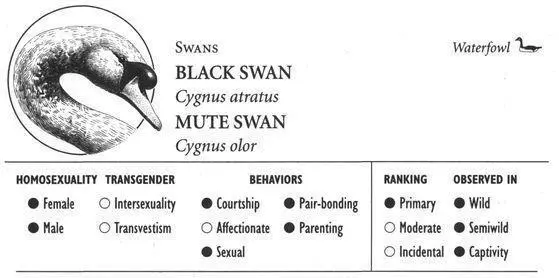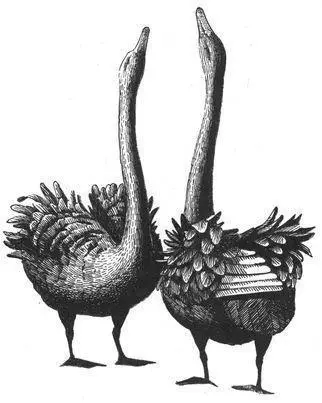Prevett, J. P. and C. D. MacInnes (1980) “Family and Other Social Groups in Snow Geese.” Wildlife Monographs 71:1–46.
*Quinn, T. W., J. C. Davies, F. Cooke, and B. N. White (1989) “Genetic Analysis of Offspring of a Female-Female Pair in the Lesser Snow Goose ( Chen c. caerulescens ) .” Auk 106:177–84.
*Starkey, E. E. (1972) “A Case of Interspecific Homosexuality in Geese.” Auk 89:456–57.
Syroechkovsky, E. V. (1979) “Podkladyvaniye byelymi gusyami yaits v chuzhiye gnyezda [The Laying of Eggs by White Geese into Strange Nests].” Zoologichesky Zhurnal 58:1033—41.
Williams, T. D. (1994) “Adoption in a Precocial Species, the Lesser Snow Goose: Intergenerational Conflict, Altruism, or a Mutually Beneficial Strategy?” Animal Behavior 47:101–7.
Zicus, M. C. (1984) “Pair Separation in Canada Geese.” Wilson Bulletin 96:129–30.

BLACK SWAN
IDENTIFICATION: The only swan with fully black plumage; wing feathers are white, bill is bright red, and the neck is especially long. DISTRIBUTION: Australia, Tasmania, New Zealand. HABITAT: Lakes, lagoons, swamps, bays, floodlands. STUDY AREAS: Lake George and Lake Bathurst, New South Wales, Australia; in captivity at the Division of Wildlife Research, Canberra, Australia.
MUTE SWAN
IDENTIFICATION: A large swan (up to 33 pounds) with a black knob at the base of its reddish orange bill (less prominent in females). DISTRIBUTION: Europe and temperate Asia. HABITAT: Marshes, ponds, lakes, slow-moving rivers, lagoons, coastal areas. STUDY AREAS: Abbotsbury (Dorset) and Rainworth Lodge (Notts), England; Renfrewshire, Scotland.
Social Organization
Black Swans sometimes flock by the thousands and usually form mated pairs (although with numerous variations—see below) that nest either colonially or in separate territories. Mute Swans also generally develop long-term, monogamous bonds and nest in widely spaced territories, although some pairs form nesting colonies. Outside of the breeding season, they often associate in flocks.
Description
Behavioral Expression: Some male Black Swans form stable, long-lasting homosexual pairs. Like heterosexual mates, same-sex partners often remain together for many years. The two males frequently perform the GREETING CEREMONY, a pair-bonding display that helps solidify and reinforce their partnership: the birds face one another, raise their wings (sometimes flapping them to expose the white feathers), and call repeatedly while extending their necks and lifting their bills up. Males in homosexual pairs also perform a courtship behavior known as HEAD-DIPPING. In this display—a prelude to copulation—the two birds repeatedly immerse first the head, then the neck, and finally the body in a wavelike fashion, sometimes for extended periods of 20–25 minutes. This can lead to homosexual mounting, although if one male does not want to participate in sexual activity he may respond aggressively to his partner’s overtures.
Male pairs of Black Swans fiercely defend territories that, during the mating season, are often significantly larger than those of heterosexual pairs. Because two males are able to pool their strength, they are more successful at chasing away other swans and can often annex a major portion of a pond (1,500–3,300 square feet) into their territory. In contrast, heterosexual pairs are often relegated to less favorable nesting areas and smaller territories (15–60 square feet). Homosexual pairs are also successful parents, acquiring nests and eggs in two different ways. Some male pairs associate temporarily with a female, building a nest together, mating with her, and then chasing her away once the eggs are laid, after which they begin parenting as a male couple. Other homosexual pairs chase heterosexual pairs from their nests and adopt the eggs that have already been laid. The two males incubate the clutch, hatch the eggs, and raise the chicks together. In fact, homosexual pairs are often more successful than heterosexual ones at raising chicks, in part because they have access to the best nesting sites and the largest territories, and probably because they also share incubation duties more equally. On average, 80 percent of homosexual parenting efforts are successful, compared to only about 30 percent of heterosexual ones.
A homosexual pair of male Black Swans performing the “greeting ceremony”

Both male and female homosexual pairs occur in Mute Swans. In female pairs, both birds build a nest, lay eggs (which are usually infertile), and incubate the eggs. Sometimes one female stands guard over both the nest and her mate (as does the male in heterosexual pairs) and defends their territory. If their nest is disturbed by intruders, the females may begin a second nest and lay a new clutch of eggs, while still attending to the first as best they can. Male pairs also annually build nests together on which they take turns sitting, although unlike Black Swans they do not acquire any eggs. Male Mute Swans also sometimes form homosexual pair-bonds with other species, including Trumpeter Swans ( Cygnus buccinator ) and Greylag Geese.
Frequency: Overall, male couples constitute 5–6 percent of all pairings in Black Swans; in a given year, an average of 13 percent of the birds are in homosexual pair-bonds, and sometimes this proportion is as high as 20 percent. Homosexual parents account for 20–25 percent of all successful families. Same-sex bonds probably occur only sporadically in Mute Swans.
Orientation: Many Black and Mute Swans in same-sex pairs are probably exclusively homosexual, since they do not engage in heterosexual copulation or pairing and usually ignore unpaired birds of the opposite sex. However, some male pairs of Black Swans—while primarily homosexual—form short-lived bisexual trios in order to mate with females and thereby father their own offspring.
Nonreproductive and Alternative Heterosexualities
Populations of both Mute and Black Swans contain large proportions of nonbreeding birds. More than half of all Mute Swans are nonbreeders (as much as 89 percent of some populations), often gathering into their own flocks separate from breeding pairs. Many birds nest only once or twice during their entire lifetimes (which can last for 15–20 years), and a few never breed. Overall, only about a fifth of all Black Swans nest in any year, and in some populations more than 90 percent of the adults do not breed. Young, sexually mature Black Swans may remain with their parents and delay their breeding for many years (as long as three to eight years in some cases). On occasion, such a youngster will form an incestuous pair-bond with its parent: male Swans have been known to mate with their mother on the death of their father. Brother-sister and parent-offspring matings also occur in Mute Swans, as do heterosexual pairings with other species of swans (such as bewick’s, whistling, whooper, and Trumpeter) and geese (e.g., Snow, Canada, and Greylag). In fact, Black and Mute Swans may pair with each other, and trios of a male Black with two female Mute Swans have also been observed. Heterosexual trios within the same species are also common: about 14 percent of all bonds in Black Swans involve two males with a female, while Mute Swan trios are usually made up of two females with a male.
Читать дальше














